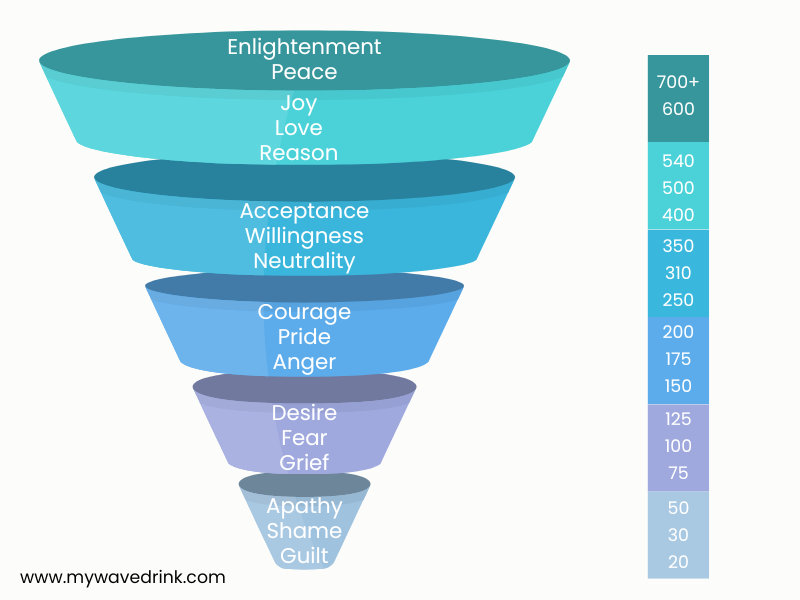現代科學揭示了一個令人驚嘆的事實:宇宙的本質是能量。從愛因斯坦的質能方程式到最新的量子物理研究,科學家們發現物質世界的根基是由無數微觀粒子組成的能量場。這些粒子以不同的頻率振動,編織出我們所見的絢麗世界。
美國著名的霍金斯博士(David R. Hawkins,《心靈能量:藏在身體裡的大智慧》作者),曾與諾貝爾物理學獎得主合作,運用肌肉測試(kinesiology)技術,結合精密的物理儀器,進行長達近三十年的臨床實驗。
他隨機選擇了來自美國、加拿大、墨西哥、南美及北歐等地的測試對象,這些人群涵蓋了不同的種族、文化、職業和年齡層。經過累積數千人的測試次數及數百萬筆資料,並經過嚴謹的統計分析,最終發現人類的不同意識層次對應著特定的能量振動頻率。
他提出意識地圖(map of consciousness)的概念,將人類的意識劃分成1-1000的刻度。 這個量表大致可以分為三個區間:
-
1-200:主要是負面情緒,如羞恥、內疚、恐懼等。
-
200-500:過渡區域,包括勇氣、中立、意願等。
-
500-1000:高頻正面能量,如愛、喜悅、平和、開悟等。

情緒能量圖表中的低頻情緒:生存的掙扎
在量表的低端,是一系列令人不快的情緒。然而很可惜的是,目前世界上 78%的人類生命能量尺度都處在 200 以下:
-
羞恥(20):幾近死亡的能量級別,讓人想要逃避或隱身。在這種狀態下,人們恨不得找個地縫鑽進去,嚴重摧殘身心健康,容易發展出蔑視的人格。
-
內疚(30):常表現為自責、懊悔,甚至可能導致自我懲罰、傷害的行為。內疚感也經常以憤怒和疲乏表現。
-
冷漠(50):對生活失去希望,感到無助和絕望。處於這個能級的人不僅看不到自己的希望,也更看不到別人和社會的陽光面。這種能量會讓人匱乏,而缺乏的不只是資源,更包含運氣等等。
-
悲傷(75):沉浸在失落和依賴中,世界在眼中變得灰暗。這是一個孤立無援的無力和消沉狀態,充滿了對過去的懊悔和自責。
-
恐懼(100):看待世界充滿危險和威脅,容易產生焦慮。在這個能級,人們懷疑別人都有故意傷害自己的傾向,容易形成強迫性的恐懼。
-
慾望(125):耗費大量精力去追求目標和回報。慾望是一個容易上癮的能級,體現了累積和貪婪的特質,但同時也可能成為達到更高層次的跳板。
-
憤怒(150):慾望帶來的挫折感則引發了憤怒。表現出怨恨和報復心理,是相當危險的。
-
驕傲(175):表面上比低能量級的情緒積極,但實際上驕傲令人脆弱且具防禦性,而且因建立在外界條件上,易受環境變化影響。驕傲助長自我膨脹,容易演變為傲慢和否認,阻礙個人成長。
這些低頻情緒曾在人類進化過程中起到重要作用,幫助我們應對生存威脅。然而,長期處於這些狀態會嚴重影響身心健康,阻礙個人成長。
情緒能量圖表中的轉折點:勇氣與意願
在霍金斯的量表中,200分是一個重要的轉折點,代表著勇氣(Courage)。這是從負面能量轉向正面能量的關鍵階段。當我們擁有勇氣時,生活開始變得充滿可能性和機遇。我們不再被恐懼所束縛,而是願意面對挑戰,學習新事物。
-
勇氣(200):這是生命動力初顯端倪的階段。擁有勇氣的人能夠拓展自我、學習技能、獲得成就,並能果斷決策。對他們來說,生活是激動人心的,充滿挑戰和樂趣。
隨著能量進一步提升,我們來到了更高的層次:
-
淡定(250):在這個能級,人們能夠靈活和無分別性地看待現實問題。他們對結果保持超然,不再深陷挫敗和恐懼、或是挑起競爭和犯罪。這樣的人通常很容易相處,給人溫馨可靠的感覺。
-
主動(310):這個層次的人通常真誠友善,樂於助人,積極地完成任務,並能為社會進步做出貢獻。他們具有自我調整的能力,能夠從逆境中汲取經驗並成長,學習他人的優點、彌補自己的不足。意願是進入更高層次的一道門。
-
寬容(350):達到這個能級的人意識到自己才是生命的主宰者。他們不再視自己為受害者,而是認識到幸福和苦難都來自內在。這種態度使他們能夠接納生活的本來面目,不刻意追求特定的結果,樂於解決困難。這種人往往展現出自律和自控的特色。
-
明智(400):這是科學、醫學和深入理解能力形成的能級。處於這個層次的人往往熱衷於學習和探索知識。許多傑出的科學家、思想家和哲學家都處於這個能級。
情緒能量圖表中的高頻情緒:愛與喜悅的力量
當我們的意識繼續提升,來到500分以上時,我們進入了愛(Love)的領域。這裡的愛並不指世俗媒體描述的情愛,而是一種無條件的、永恆的愛。這種愛不受外界因素影響,是發自內心、寬容的,滋養著生命成長的無限動力。處於這個層次的人往往能夠看到生活中美好的一面,累積積極的經驗,以體會到真正的幸福。
更高的層次包括:
-
喜悅(540):這是一種從內在升起的持久喜悅,不依賴於外在條件。達到這個層次的人通常具有顯著的治療能力和精神獨立性。他們對生活中出現的困境保持樂觀的態度和慈悲,同時能夠他人帶來愛與平靜。
-
平和(600):這個能級與自我實現和昇華的意識有關。達到這個層次的人非常稀有,大約每一千萬人中才有一個。在這個層次,內外的區分消失了,世界一切都呈現出生機勃勃和光芒四射的狀態,彷彿不再隨世俗的時間輕易消逝,而能感受到整個宇宙流轉運行的能量。
-
開悟(700-1000):這是人類意識進化的頂峰。達到這個層次的人不再對身體有「我」的執著,而是將身體視為乘載意識的工具。這是完全合一的狀態,代表了意識與神性的融合。 700 是霍金斯遇到過最高的頻率,當特雷莎走進研究室的瞬間,所有人都感受到了莫名的喜悅與平靜。 而 1000 則是歷代無數偉人、宗教精神模範的能量,作為最高智慧的正覺,靈感與真理源源不絕地從他們湧出。
如何提升自己的能量?
首先,「自我覺察」是第一步。經常留意自己的情緒狀態,了解自己目前處於哪個能量層級。而要提升覺察力,許多人都會透過正念、冥想等練習來培養清晰的心理狀態。在處於低能量時可以即時意識到,並且有更能力平復、走出這種低頻狀態。
再者,能量是會互相影響的。有意識地選擇能量較高的環境、人際關係和活動,避免長期處於低能量場所。此外持續學習也是很重要的一環,透過閱讀啟發性、含有高能量內容的經典著作,能夠不斷提升自己的意識水平。
霍金斯的研究還揭示了一個驚人的事實:一個高能量個體可以抵消大量低能量個體的影響。例如,一個處於「愛」(500) 層級的人,其正面影響力相當於750,000個處於200分以下的人的總和。這意味著,個人的意識提升不僅對自己有益,還能為整個社會帶來巨大的正面影響。
當越來越多的人達到較高的能量狀態,並且有餘裕幫助互惠他人時,整個社會的氛圍都會隨之改變,變得更加和諧、慈悲和富有創造力。
大衛·霍金斯的情緒能量表為我們提供了一個全新的視角,幫助我們理解自己的內在世界和成長軌跡。它不僅是一個理論框架,更是一個實用的工具,指引我們如何在日常生活中不斷提升自己,到達更平和、喜悅的理想狀態。
Source:
https://sunroomstory.wordpress.com/2022/11/01/【自癒情緒】淺談map-of-consciousness-意識能量地圖中的各情/
https://catwang0717.pixnet.net/blog/post/310441667
http://hyawave.blogspot.com/2018/08/blog-post_28.html

David Hawkins' Scale of Emotions: The Consciousness Map Towards High-Frequency Energy
Modern science has revealed an astonishing fact: the essence of the universe is energy. From Einstein's mass-energy equivalence to the latest quantum physics research, scientists have discovered that the foundation of the material world is an energy field composed of countless microscopic particles. These particles vibrate at different frequencies, weaving the colorful world we see.
The renowned American Dr. David R. Hawkins, author of "Power vs. Force," collaborated with Nobel Prize winners in physics, using kinesiology techniques combined with precise physical instruments to conduct clinical experiments over nearly thirty years.
He randomly selected test subjects from the United States, Canada, Mexico, South America, and Northern Europe, covering various races, cultures, professions, and age groups. After accumulating thousands of test cases and millions of data points, followed by rigorous statistical analysis, he ultimately discovered that different levels of human consciousness correspond to specific energy vibration frequencies.
He proposed the concept of a map of consciousness, dividing human consciousness into a scale from 1 to 1000. This scale can be roughly divided into three intervals:
-
1-200: Mainly negative emotions, such as shame, guilt, fear, etc.
-
200-500: Transition zone, including courage, neutrality, willingness, etc.
-
500-1000: High-frequency positive energy, such as love, joy, peace, enlightenment, etc.

Low-Frequency Emotions in the Emotional Energy Scale: The Struggle for Survival
At the lower end of the scale, we find a series of unpleasant emotions. Unfortunately, 78% of the world's population currently resides below the energy level of 200:
-
Shame (20): An energy level close to death, making one want to escape or hide. In this state, people wish they could disappear, severely damaging both mental and physical health, and easily developing a contemptuous personality.
-
Guilt (30): Often manifests as self-blame and regret, potentially leading to self-punishing, harmful behaviors. Feelings of guilt also frequently appear as anger and fatigue.
-
Apathy (50): Loss of hope for life, feeling helpless and desperate. People at this energy level not only can't see hope for themselves but also fail to see the bright side of others and society. This energy leads to deprivation, lacking not just resources but also luck and other aspects.
-
Grief (75): Immersed in loss and dependency, the world appears gray. This is a state of helplessness and depression, isolated and full of regret and self-blame for the past.
-
Fear (100): Viewing the world as full of danger and threats, prone to anxiety. At this level, people suspect others of intentionally wanting to harm them, easily forming compulsive fears.
-
Desire (125): Expending a lot of energy pursuing goals and rewards. Desire is an addictive energy level, embodying accumulation and greed, but it can also potentially become a springboard to reach higher levels.
-
Anger (150): The frustration brought by desire leads to anger. It manifests as resentment and a vengeful mindset, which is quite dangerous.
-
Pride (175): Superficially more positive than lower energy levels, but in reality, pride makes people vulnerable and defensive. Being based on external conditions, it's easily affected by environmental changes. Pride fuels self-inflation and can easily evolve into arrogance and denial, hindering personal growth.
These low-frequency emotions once played important roles in human evolution, helping us respond to survival threats. However, long-term exposure to these states severely affects physical and mental health, hindering personal growth.
The Turning Point in the Emotional Energy Scale: Courage and Willingness
In Hawkins' scale, 200 points marks an important turning point, representing Courage. This is the key stage in transitioning from negative to positive energy. When we have courage, life begins to fill with possibilities and opportunities. We are no longer bound by fear but are willing to face challenges and learn new things.
-
Courage (200): This is the stage where life force begins to emerge. People with courage can expand themselves, learn skills, achieve success, and make decisive decisions. For them, life is exciting, full of challenges and fun.
As energy continues to rise, we reach higher levels:
-
Neutrality (250): At this level, people can flexibly and non-discriminatively view real-world problems. They remain detached from outcomes, no longer mired in frustration and fear, or inciting competition and crime. Such people are usually easy to get along with, giving a sense of warmth and reliability.
-
Willingness (310): People at this level are usually sincere and friendly, willing to help, actively completing tasks, and able to contribute to social progress. They have the ability to self-adjust, learn from adversity and grow, learning from others' strengths to compensate for their own weaknesses. Willingness is a gateway to higher levels.
-
Acceptance (350): People who reach this level realize that they are the masters of their own lives. They no longer see themselves as victims but recognize that happiness and suffering come from within. This attitude allows them to accept life as it is, not deliberately pursuing specific outcomes, and being willing to solve difficulties. Such people often exhibit characteristics of self-discipline and self-control.
-
Reason (400): This is the energy level where science, medicine, and deep understanding abilities are formed. People at this level are often passionate about learning and exploring knowledge. Many outstanding scientists, thinkers, and philosophers are at this level.
High-Frequency Emotions in the Emotional Energy Scale: The Power of Love and Joy
As our consciousness continues to rise, reaching above 500 points, we enter the realm of Love. The love here is not the romantic love described by secular media, but an unconditional, eternal love. This love is not affected by external factors; it comes from the heart, is tolerant, and nourishes the infinite driving force of life growth. People at this level often see the beauty in life, accumulate positive experiences, and experience true happiness.
Higher levels include:
-
Joy (540): This is a lasting joy that arises from within, not dependent on external conditions. People who reach this level usually have significant healing abilities and spiritual independence. They maintain an optimistic attitude and compassion towards the difficulties that arise in life, while also being able to bring love and peace to others.
-
Peace (600): This energy level is related to self-realization and transcendent consciousness. People who reach this level are very rare, about one in ten million. At this level, the distinction between inner and outer disappears, and everything in the world appears vibrant and radiant, as if no longer easily passing with worldly time, but able to feel the energy of the entire universe's rotation and operation.
-
Enlightenment (700-1000): This is the peak of human consciousness evolution. People who reach this level no longer have an attachment to the "self" of the body but view the body as a tool for carrying consciousness. This is a state of complete unity, representing the fusion of consciousness and divinity. 700 is the highest frequency Hawkins has encountered; when Mother Teresa walked into the research lab, everyone felt an inexplicable joy and peace. 1000 represents the energy of countless great figures and religious spiritual models throughout history, as the highest wisdom of right mindfulness, with inspiration and truth flowing endlessly from them.
How to Raise Your Energy?
First, "self-awareness" is the first step. Regularly pay attention to your emotional state and understand which energy level you are currently at. To enhance awareness, many people practice mindfulness and meditation to cultivate a clear mental state. This allows you to immediately recognize when you're at a low energy state and have more ability to calm down and move out of this low-frequency state.
Moreover, energy is mutually influential. Consciously choose environments, relationships, and activities with higher energy, avoiding long-term exposure to low-energy places. Continuous learning is also a crucial aspect; by reading inspiring, high-energy content from classic works, you can continuously raise your level of consciousness.
Hawkins' research also revealed an astonishing fact: a high-energy individual can offset the influence of a large number of low-energy individuals. For example, a person at the "Love" (500) level has a positive influence equivalent to 750,000 people below 200 points. This means that raising individual consciousness not only benefits oneself but can also bring enormous positive impacts to the entire society.
As more and more people reach higher energy states and have the capacity to help and benefit others, the entire social atmosphere will change accordingly, becoming more harmonious, compassionate, and creative.
David Hawkins' emotional energy scale provides us with a new perspective, helping us understand our inner world and growth trajectory. It is not just a theoretical framework but a practical tool, guiding us on how to continuously improve ourselves in daily life, reaching a more peaceful and joyful ideal state.
Source:
https://sunroomstory.wordpress.com/2022/11/01/【自癒情緒】淺談map-of-consciousness-意識能量地圖中的各情/
https://catwang0717.pixnet.net/blog/post/310441667
http://hyawave.blogspot.com/2018/08/blog-post_28.html



